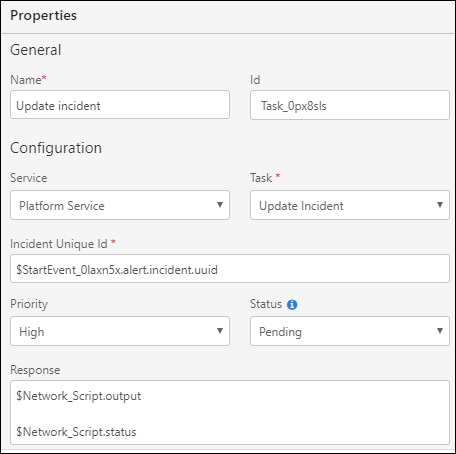Introduction
A task refers to a single unit of work to be performed in a process.
The following tasks are supported:
- Send task
- Script task
- Service task
Send task properties
A send task sends a notification to one or more users at a specific point in the process.
The send task is represented as a rectangle with rounded corners with a small notification icon at the corner:
A send task has the following properties:
| Property | Description |
|---|---|
| Name | The name of the task. |
| Id | A unique identifier of the task generated by the system. An ID cannot be modified. |
| Input | The object from the previous element's object. |
| Notification Template | The user who is sent a notification. |
| Notification Priority | The priority that determines the channel (email) to deliver notifications. |
Script task properties
A script task is used to run a script in the process. A script can be agent-based or agentless via Ansible control node. Agent-based scripts can be created in the following languages:
- POWERSHELL
- Python
- SHELL
The script task is represented with a rectangle with rounded corners and a script icon:

To run an agentless script, integrate Ansible must be integrated with the system.
To configure Ansible integration:
- From All Clients, select the client.
- Go to Setup > Integrations> Integrations.
- From Available Integrations > Configuration Automation > Ansible Integration, click Install.
- Enter a name for the integration and select the controller host name.
- Click Install.
A script task has the following properties:
| Property | Description |
|---|---|
| Name | The name of the task. |
| Id | A unique identifier of the task generated by the system. An ID cannot be modified. |
| Configuration |
|
| Script Name (applicable for an agent) | The script name to execute. |
| Resource Id (applicable for agent) | The resource ID used to execute the script. |
| Run As (applicable for agent) | The execution of the script with proper authorization.
|
| Integration (applicable for agentless) | A created Ansible integration name. |
| Playbook (applicable for agentless) | A Playbook created as part of the integration. |
| Input (applicable for agentless) | Commands for executing the script. |
| Preview (applicable for agentless) | The fully-qualified path entered in a selected playbook. |
Service task properties
A service task is used to perform a service. The service can either be a service provided by OpsRamp or an external service. The service task is represented as a rectangle with rounded corners with a settings icon:

Service tasks have the following properties:
| Property | Description |
|---|---|
| Name | The name of the task. |
| Id | A unique identifier for the task generated by the system. An ID cannot be modified. |
| Service | The mode of service for completing a task:
|
REST web services
REST web services have the following properties:
| Property | Description |
|---|---|
| Asynchronous Service Invocation | An asynchronous service invocation follows the Request, Acknowledge, and Callback pattern. Once invoked, the process is blocked for this task until the REST application performs a callback. |
| Integration | The integration of an external web service API endpoints that is configured. |
| Event | An integration event. |
| Input | The input for the service task that can be an output of the previously configured elements (like the start event). Example: $startevent.alert or $updatealert.alert. |
| Output | The mappings of response fields configured for the selected event. |
This is an example of the REST web services properties dialog box:

Service Task Properties - REST Web Service
Platform services
The platform services has the following properties:
| Property | Description |
|---|---|
| Task | Refers to one of the OpsRamp’s native services. The sub-fields vary for each task that you select. For example, if Update Incident is selected, the Incident Unique Id needs to provided, select Priority and Status. Enter the comments to add to the incident as part of the response. |
Note
Either static or dynamic values provided for the fields. If the Incident Unique Id is INC0000260733, then that incident is updated. However, if incident ID is not known or the incident of an alert related to the start event needs to be updated, enter a dynamic value as $StartEvent_1vu43p8.alert.incident.This is an example of the platform service properties dialog box:
